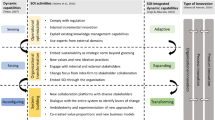Abstract
The complex pathways from innovation to impact mean that unintended spillover effects on non-target objectives are always likely. This generates a third reason—in addition to accelerators and complementarity in pursuit of target objectives—why socio-technical bundles are important. Herrero et al. (2020, 2021) demonstrated that food systems innovations can have mostly neutral or positive effects on the food systems SDGs (left-hand panel of Fig. 1).
You have full access to this open access chapter, Download chapter PDF
Similar content being viewed by others

The complex pathways from innovation to impact mean that unintended spillover effects on non-target objectives are always likely. This generates a third reason—in addition to accelerators and complementarity in pursuit of target objectives—why socio-technical bundles are important. Herrero et al. (2020, 2021) demonstrated that food systems innovations can have mostly neutral or positive effects on the food systems SDGs (left-hand panel of Fig. 1). The likely impacts on non-food system SDGs, however, are more variable and not always positive (right-hand panel of Fig. 1). This was especially true for the SDGs concerned with growth (SDG 8); equity (SDG 10); and peace, justice, and strong institutions (SDG 16). Particularly those technologies related to digital agriculture, access to inputs, or increases in resource use efficiency could lead to significant winners and losers both, where the capacity of implementing these technologies—which require more education, good access to finance, and systems geared towards commercialization—might only allow some actors to engage beneficially.
Net impacts of different technology domains on food systems–related SDGs and their indirect effects on other SDGs. Indirect effects are mediated via the interactions between SDGs as quantified by Pradhan et al. (2017). Dark, mid, or light blue squares represent strong, moderate, or weak positive impacts/interactions, while grey or red squares represent neutral or negative interactions and/or impacts, respectively (Reproduced from Herrero et al. 2021)
These diverse spillover effects obviously depend on the specific type of technological intervention. As Herrero et al. (2021) demonstrate, drawing on expert Delphi assessments, the anticipated direct impacts of individual AFS technologies exhibit considerable heterogeneity of potential direct impacts, quite apart from the indirect effects arising from spillovers (Fig. 2). While some innovations could have very significant positive impacts, others could have neutral or negative effects on some SDGs. Additionally, while some could have highly positive impacts on one particular SDG, that same technology could exhibit a dramatically different direct impact on another SDG.
Range of potential direct impacts of anticipated technologies across SDGs. Direct impacts are those that occur on the SDGs that directly relate to food systems. Indirect impacts, by contrast, are those mediated through the impacts of food systems technologies on non-food system–related SDGs. The small blue bars represent an average score of all respondents for an individual technology (Reproduced from Herrero et al. 2021)
This is precisely what happened in prior eras of AFS transformation. For example, the Green Revolution introduction of improved cereals varieties, accompanied by increased irrigation and inorganic fertilizer application, elicited its desired and anticipated positive effects on staple crop productivity. But it also had less favorable direct effects on other key outcomes (e.g., water pollution) and very mixed indirect effects on still others (e.g., obesity and micronutrient deficiencies, and deforestation). The complex pathways from innovation to impact compel both broadly participatory engagement and bundling of distinct innovations, as well as careful attention paid to cultural, institutional, and policy environments that condition net impacts.
It is therefore essential to construct mental impact pathways as part of designing transition pathways for any technological intervention in AVCs (Herrero et al. 2020, 2021). The complexity of that exercise almost inevitably requires broad stakeholder engagement and can sometimes be usefully supported by sophisticated modeling. These impact pathway mapping exercises often reveal key trade-offs and synergies arising from the multi-sectoral nature of the impacts associated with socio-technological bundles. They help identify key objectives and the indicators necessary to monitor progress towards (or away from!) those objectives. And they permit contingency planning for actions necessary to prevent or remedy undesired consequences.
Even with the best intentions, if AFS innovators focus only on direct AFS impacts, they risk adverse impacts on other, distal objectives. Because many such impacts are predictable, even if unintended, they can excite opposition to, and obstruction of, emergent technologies if a conscious effort is not made through complementary actions—a socio-technical innovation bundle—to safeguard other critical elements of human well-being. In a pluralistic society, one must build coalitions of support by bundling complementary efforts that enable gains in one or more dimensions while protecting people against losses in some other dimension. The bundling strategy enables the minimization of unproductive, zero-sum contests.
As two examples, Fig. 3 shows a range of pathways to impact for two emerging, but very different, technologies: circular feeds and nitrogen fixation in cereals. These are discussed in detail above and in Herrero et al. (2021). The purpose here is not to explain each of the illustrated links—which Herrero et al. (2021) does—merely to highlight the deep interconnections that link various outcomes’ responses to the introduction of even a single new technology. An innovation intended to advance progress towards one SDG inevitably generates direct and indirect effects on other SDGs as well. These spillovers are intrinsic to AFS and are one reason why bundling of social and technological innovations is so crucial to harnessing the potential of science to transform AFS.
Potential impact pathways of two case-study technological innovations towards the food-related SDGs: (above) personalized nutrition and (below) nitrogen-fixing cereals. Blue (red) arrows depict positive (negative) expected net impacts (Reproduced from Herrero et al. 2021)
Clearly these two technologies are being researched and sold to research agencies, venture capitalists, and the public with their intended positive impacts in mind. A more detailed examination, however, reveals positive impacts in some SDG domains—perhaps even in unintended domains—but not in others. This highlights the pervasiveness of spillover effects and the enormous difficulty of simultaneously achieving uniformly positive outcomes across SDGs. Hence the need for bundling, for broadly participatory innovation processes, and for close monitoring of a dashboard of KPMs of AFSs and beyond. We need to think not only of key accelerators and processes to ensure the adaptation and upscaling of impactful new technologies, but equally to think and plan early in the adoption and diffusion process for corrective or compensatory measures to address negative, unintended spillover effects as, and where, they emerge.
The complex pathways to impact illustrate the necessity of thinking in terms of socio-technical innovation bundles. These are necessary in the narrowest sense, to ensure the presence of socio-cultural accelerators to promote adaptation and diffusion of beneficial individual innovations, and to clear socio-cultural obstacles to upscaling. But they are, perhaps, even more important in the broader sense of addressing the inevitable spillovers and tradeoffs across diverse, desired outcomes. While innovation can often create the potential for Pareto improvements and thereby obviate the need for the typically painful zero-sum politics of food-price dilemmas—where any price change generates both winners and losers, and thus stark opposition—it still requires negotiation and compromise. Apolitical technological change does not exist. There are always winners. If navigated thoughtfully and inclusively, however, there need not be losers, just compromise to share the gains enabled by scientific and institutional advances.
The right socio-technical bundle, therefore, depends fundamentally on the system and on the actors involved. We cannot be overly prescriptive, as no one-size-fits-all solutions exist. The point, rather, is that one must look for contextually appropriate bundles and not naively assume that an emblematic technology will automatically diffuse, much less generate favorable, intended impacts without adverse, unintended impacts. For example, biofortification of staple crops with vitamins or minerals widely deficient in the diets of poor consumers is an extremely promising tool for advancing equitable livelihoods and healthy diets objectives in some rural and traditional systems. The crop genetic advances in biofortified germplasm often must be combined with improved agronomic practices to ensure healthy soils that deliver the needed vitamins/minerals to the re-engineered plants, with supporting seed replication and distribution systems, and with agricultural extension and nutritional education programming to inform farmers, shoppers, and caregivers of the benefits and recommended use patterns of the new variety. The precise components of biofortification-based socio-technical bundles necessarily vary, however, across crops, minerals, and AFS types. Moreover, biofortification is less useful in industrial and consolidated systems where micronutrient deficiencies have rather different etiology. The right bundle must be decided by gathering the suite of stakeholders engaged in the AFS.
References
Herrero, Mario, Philip K. Thornton, Daniel Mason-D’Croz, Jeda Palmer, Tim G. Benton, Benjamin L. Bodirsky, Jessica R. Bogard, et al. 2020. Innovation can accelerate the transition towards a sustainable food system. Nature Food 1 (5): 266–272. https://doi.org/10.1038/s43016-020-0074-1.
Herrero, Mario, Philip K. Thornton, Daniel Mason-D’Croz, J. Palmer, B. L. Bodirsky, P. Pradhan, C. B. Barrett, T. G. Benton, et al. 2021. Articulating the impact of food systems innovation on the Sustainable Development Goals. The Lancet Planetary Health 5 (1): e50–e62. https://doi.org/10.1016/S2542-5196(20)30277-1.
Pradhan, Prajal, Luís Costa, Diego Rybski, Wolfgang Lucht, and Jürgen P. Kropp. 2017. A systematic study of Sustainable Development Goal (SDG) interactions. Earth’s Future 5 (11): 1169–1179. https://doi.org/10.1002/2017EF000632.
Author information
Authors and Affiliations
Corresponding author
Rights and permissions
Open Access This chapter is licensed under the terms of the Creative Commons Attribution 4.0 International License (http://creativecommons.org/licenses/by/4.0/), which permits use, sharing, adaptation, distribution and reproduction in any medium or format, as long as you give appropriate credit to the original author(s) and the source, provide a link to the Creative Commons license and indicate if changes were made.
The images or other third party material in this chapter are included in the chapter's Creative Commons license, unless indicated otherwise in a credit line to the material. If material is not included in the chapter's Creative Commons license and your intended use is not permitted by statutory regulation or exceeds the permitted use, you will need to obtain permission directly from the copyright holder.
Copyright information
© 2022 The Author(s)
About this chapter
Cite this chapter
Barrett, C.B. et al. (2022). Impact Pathways. In: Socio-Technical Innovation Bundles for Agri-Food Systems Transformation. Sustainable Development Goals Series. Palgrave Macmillan, Cham. https://doi.org/10.1007/978-3-030-88802-2_8
Download citation
DOI: https://doi.org/10.1007/978-3-030-88802-2_8
Published:
Publisher Name: Palgrave Macmillan, Cham
Print ISBN: 978-3-030-88801-5
Online ISBN: 978-3-030-88802-2
eBook Packages: Economics and FinanceEconomics and Finance (R0)







